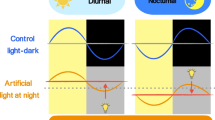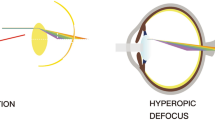Abstract
Iris melanocytes are innervated by parasympathetic and sympathetic nerve endings. Light affects autonomic nervous system activity via the retino-hypothalamic pathway. The hypothesis that the day-to-night variations in the sympatovagal ratio (LF/HF) may differ among individuals with different brown iris patterns was tested. A total of 621 healthy adults, aged between 16 and 50, with brown eyes and not diagnosed with a disease that might affect the autonomous nerve system were included in the study. A digital camera was used to acquire iris photos. Subjects were grouped into iris color groups (2–0 bg, 1–0 bg, 1–1 db, 1–1 lb, 2–0 b, and 1–0 b). Iris photos were analyzed with Picture Color Analyzer RBG software. The Central/Peripheral (R/RGB) ratio was used for objective distinction between the groups. Using 24-h Holter ECG monitoring, the change in the sympathovagal ratio from day (between 07:00 and 23:00 h) to night (between 23:00 and 07:00 h) was determined with the formula [(Day–Night) LF/HF)/Day LF/HF]. The frequency of subjects with a decrease in the LF/HF ratio from day to night was the highest in the 1–1 db group (65.7%), followed by the 1–1 lb group (56.4%). The highest increase was in the 2–0 bg group (76.5%), followed by the 1–0 B group (68.9%) (p < 0.001). Based on the findings of this study, iris color may be a predictive factor in diseases in which the circadian change of autonomic nervous system activity is effective.


Similar content being viewed by others
References
Hu DN, Simon JD, Sarna T. Role of ocular melanin in ophthalmic physiology and pathology. Photochem Photobiol. 2008;84(3):639–44. https://doi.org/10.1111/j.1751-1097.2008.00316.x.
Mukuno K, Witmer R. Innervation of melanocytes in human iris. An electron microscopic study. Albrecht Von Graefes Arch Klin Exp Ophthalmol. 1977;203(1):1–8. https://doi.org/10.1007/BF00410042.
Pavan WJ, Raible DW. Specification of neural crest into sensory neuron and melanocyte lineages. Dev Biol. 2012;366(1):55–63. https://doi.org/10.1016/j.ydbio.2012.02.038.
Hannibal J. Comparative neurology of circadian photoreception: the retinohypothalamic tract (RHT) in sighted and naturally blind mammals. Front Neurosci. 2021;15: 640113. https://doi.org/10.3389/fnins.2021.640113.
Kiessling S, Sollars PJ, Pickard GE. Light stimulates the mouse adrenal through a retinohypothalamic pathway independent of an effect on the clock in the suprachiasmatic nucleus. PLoS ONE. 2014;9(3): e92959. https://doi.org/10.1371/journal.pone.0092959.
Panza JA, Epstein SE, Quyyumi AA. Circadian variation in vascular tone and its relation to α-sympathetic vasoconstrictor activity. N Engl J Med. 1991;325:986–90. https://doi.org/10.1056/NEJM199110033251402.
von Rosenberg W, Chanwimalueang T, Adjei T, et al. Resolving ambiguities in the LF/HF ratio: LF-HF scatter plots for the categorization of mental and physical stress from HRV. Front Physiol. 2017;8:360. https://doi.org/10.3389/fphys.2017.00360.
Parmeggiani PL, Morrison AR. Alterations in autonomic functions during sleep. In: Loewy AD, Spyer KM, editors. Central regulation of autonomic functions. New York: Oxford University Press; 1990.
Mackey DA, Wilkinson CH, Kearns LS, Hewitt AW. Classification of iris colour: review and refinement of a classification schema. Clin Exp Ophthalmol. 2011;39(5):462–71. https://doi.org/10.1111/j.1442-9071.2010.02487.x.
Otaka I, Kumagai K, Inagaki Y, et al. Simple and inexpensive software designed for the evaluation of color. Am J Ophthalmol. 2002;133(1):140–2. https://doi.org/10.1016/s0002-9394(01)01213-2.
Task Force of the European Society of Cardiology the North American Society of Pacing Electrophysiology Heart Rate Variability Standards of Measurement, Physiological Interpretation, and Clinical Use Circulation. 1996;93:1043–1065
Billman GE. The LF/HF ratio does not accurately measure cardiac sympatho-vagal balance. Front Physiol. 2013;20(4):26. https://doi.org/10.3389/fphys.2013.00026.
Hale BD, Landers DM, Snyder Bauer R, Goggin NL. Iris pigmentation and fractionated reaction and reflex time. Biol Psychol. 1980;10(1):57–67. https://doi.org/10.1016/0301-0511(80)90007-1.
Markle A. Eye color and responsiveness to arousing stimuli. Percept Mot Skills. 1976;43(1):127–33. https://doi.org/10.2466/pms.1976.43.1.127.
Rosenberg A, Kagan J. Iris pigmentation and behavioral inhibition. Dev Psychobiol. 1987;20(4):377–92. https://doi.org/10.1002/dev.42020040.
Takeda K, Takahashi NH, Shibahara S. Neuroendocrine functions of melanocytes: beyond the skin-deep melanin maker. Tohoku J Exp Med. 2007;211(3):201–21. https://doi.org/10.1620/tjem.211.201.
Dryja TP, Kimball GP, Albert DM. Light stimulation of iris tyrosinase in vivo. Invest Ophthalmol Vis Sci. 1980;19(5):559–62.
Albert DM, McGuire JS, Bernard GD, Sherry P. Iris melanocyte response to MSH and related drugs. Yale J Biol Med. 1973;46:702.
Applebury ML, Hargrave PA. Molecular biology of the visual pigments. Vision Res. 1986;26(12):1881–95. https://doi.org/10.1016/0042-6989(86)90115-x.
McCartney AC, Riordan-Eva P, Howes RC, Spalton DJ. Horner’s syndrome: an electron microscopic study of a human iris. Br J Ophthalmol. 1992;76(12):746–9. https://doi.org/10.1136/bjo.76.12.746.
Foster RG, Hughes S, Peirson SN. Circadian Photoentrainment in Mice and Humans. Biology (Basel). 2020;9(7):180. https://doi.org/10.3390/biology9070180.
Iyengar B. Melatonin and melanocyte functions. Biol Signals Recept. 2000;9(5):260–6. https://doi.org/10.1159/000014648.
Osborne NN, Chidlow G. The presence of functional melatonin receptors in the iris-ciliary processes of the rabbit eye. Exp Eye Res. 1994;59(1):3–9. https://doi.org/10.1006/exer.1994.1076.
Dominguez-Rodriguez A, Abreu-Gonzalez P, Reiter RJ. Melatonin and cardiovascular disease: myth or reality? Rev Esp Cardiol (Engl Ed). 2012;65(3):215–8. https://doi.org/10.1016/j.recesp.2011.10.009.
Bashkatov AN, Genina E A, Koblov E V, et al. Proc. of SPIE Vol. 6085, 60850N, Complex Dynamics and Fluctuations in Biomedical Photonics III 2006;1605–7422/06/15. Estimation of melanin content in iris of human eye: prognosis for glaucoma diagnostics. https://doi.org/10.1117/12.659176
Vandewalle GG, Schwartz S, Grandjean D, et al. Spectral quality of light modulates emotional brain responses in humans. Proc Natl Acad Sci U S A. 2010;107(45):19549–54. https://doi.org/10.1073/pnas.1010180107.
Lucas RJ, Peirson SN, Berson DM, et al. Measuring and using light in the melanopsin age. Trends Neurosci. 2014;37(1):1–9. https://doi.org/10.1016/j.tins.2013.10.004.
IJspeert JK, de Waard PW, van den Berg TJ, de Jong PT. The intraocular straylight function in 129 healthy volunteers; dependence on angle, age and pigmentation. Vision Res. 1990;30(5):699–707. https://doi.org/10.1016/0042-6989(90)90096-4.
van den Berg TJ, IJspeert JK, de Waard PW. Dependence of intraocular straylight on pigmentation and light transmission through the ocular wall. Vision Res. 1991;31(7–8):1361–7. https://doi.org/10.1016/0042-6989(91)90057-c.
Mien IH, Pin CEC, Lau P, et al. Effects of exposure to intermittent versus continuous red light on human circadian rhythms, melatonin suppression, and pupillary constriction. PLoS ONE. 2014;9(5): e96532. https://doi.org/10.1371/journal.pone.0096532.
Eglen RM. Muscarinic receptor subtype pharmacology and physiology. Prog Med Chem. 2005;43:105–36. https://doi.org/10.1016/S0079-6468(05)43004-0.
Yamada M, Miyakawa T, Duttaroy A, et al. Mice lacking the M3 muscarinic acetylcholine receptor are hypophagic and lean. Nature. 2001;410(6825):207–12. https://doi.org/10.1038/35065604.
Niggemann B, Weinbauer G, Vogel F, Korte R. A standardized approach for iris color determination. Int J Toxicol. 2003;22(1):49–51. https://doi.org/10.1080/10915810305081.
Koblova EV, Bashkatov AN, Dolotov LE, et al. Monte Carlo modeling of eye iris color. Saratov Fall Meeting 2006: Optical Technologies in Biophysics and Medicine VIII. Proceedings of the SPIE, Volume 6535, 653521. https://doi.org/10.1117/12.741086
Funding
None.
Author information
Authors and Affiliations
Contributions
ŞK: selection of subjects, their clinical evaluation, acquisition of Holter ECGs and their analysis, iris photo shoot, iris color measurement, interpretation of data for the work, and writing. AEK: data interpretation, iris color measurement, final approval of the version to be published, revision of the manuscript.
Corresponding author
Ethics declarations
Conflict of interest
Authors declare that they have no conflict of interest.
Additional information
Publisher's Note
Springer Nature remains neutral with regard to jurisdictional claims in published maps and institutional affiliations.
Rights and permissions
Springer Nature or its licensor (e.g. a society or other partner) holds exclusive rights to this article under a publishing agreement with the author(s) or other rightsholder(s); author self-archiving of the accepted manuscript version of this article is solely governed by the terms of such publishing agreement and applicable law.
About this article
Cite this article
Koç, Ş., Koç, A.E. Iris color and day–night changes in the sympathovagal ratio. Sleep Biol. Rhythms 22, 191–198 (2024). https://doi.org/10.1007/s41105-023-00492-y
Received:
Accepted:
Published:
Issue Date:
DOI: https://doi.org/10.1007/s41105-023-00492-y




